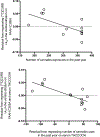Fatty acid amide hydrolase is lower in young cannabis users
- PMID: 31960544
- PMCID: PMC7944390
- DOI: 10.1111/adb.12872
Fatty acid amide hydrolase is lower in young cannabis users
Abstract
We have recently shown that levels of fatty acid amide hydrolase (FAAH), the enzyme that metabolizes the endocannabinoid anandamide, are lower in the brains of adult cannabis users (CUs) (34 ± 11 years of age), tested during early abstinence. Here, we examine replication of the lower FAAH levels in a separate, younger cohort (23 ± 5 years of age). Eighteen healthy volunteers (HVs) and fourteen CUs underwent a positron emission tomography scan using the FAAH radioligand [11 C]CURB. Regional [11 C]CURB binding was calculated using an irreversible two-tissue compartment model with a metabolite-corrected arterial plasma input function. The FAAH C385A genetic polymorphism (rs324420) was included as a covariate. All CUs underwent a urine screen to confirm recent cannabis use and had serum cannabinoids measured. One CU screened negative for cannabinoids via serum and was removed from analysis. All HVs reported less than five lifetime cannabis exposures more than a month prior to study initiation. There was a significant effect of group (F1,26 = 4.31; P = .048) when two A/A (rs324420) HVs were removed from analysis to match the genotype of the CU group (n = 16 HVs, n = 13 CUs). Overall, [11 C]CURB λk3 was 12% lower in CU compared with HV. Exploratory correlations showed that lower brain [11 C]CURB binding was related to greater use of cannabis throughout the past year. We confirmed our previous report and extended these findings by detecting lower [11 C]CURB binding in a younger cohort with less cumulative cannabis exposure.
Keywords: [11C]CURB; addiction; anandamide; cannabis; fatty acid amide hydrolase; positron emission tomography.
© 2020 Society for the Study of Addiction.
Conflict of interest statement
Disclosures
RFT has consulted for Quinn Emmanual and Apotex, and is a member of numerous scientific advisory boards, on unrelated topics. All other authors report no biomedical financial interests or potential conflicts of interest.
Figures


References
-
- UNODC. World Drugs Report. Vienna: United Nations Publications; 2019.
-
- Health Canada. Canadian Tobacco, Alcohol and Drugs Survey (CTADS): summary of results for 2017 website. https://www.canada.ca/en/health-canada/services/canadian-tobacco-alcohol.... Updated January 4, 2019. Accessed August 4, 2019.
-
- Johnston LD, O’Malley PM, Bachman JG, & Schulenberg JE. Monitoring the Future national survey results on drug use, 1975–2012: Volume I, Secondary school students. Ann Arbor: Institute for Social Research, The University of Michigan; 2013, p. 361.
-
- Volkow ND, Compton WM, Weiss SR. Adverse health effects of marijuana use. N Engl J Med. 2014;371:879. - PubMed
-
- National Academies of Sciences, Engineering, and Medicine; Health and Medicine Division; Board on Population Health and Public Health Practice; Committee on the Health Effects of Marijuana: An Evidence Review and Research Agenda. The Health Effects of Cannabis and Cannabinoids: The Current State of Evidence and Recommendations for Research. Washington (DC): National Academies Press (US); 2017, Therapeutic Effects of Cannabis and Cannabinoids. Available from: https://www.ncbi.nlm.nih.gov/books/NBK425767/#
Publication types
MeSH terms
Substances
Grants and funding
LinkOut - more resources
Full Text Sources
Medical
Miscellaneous

